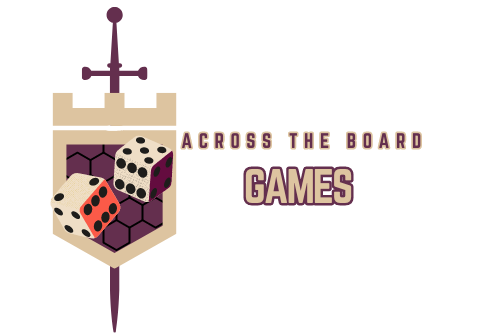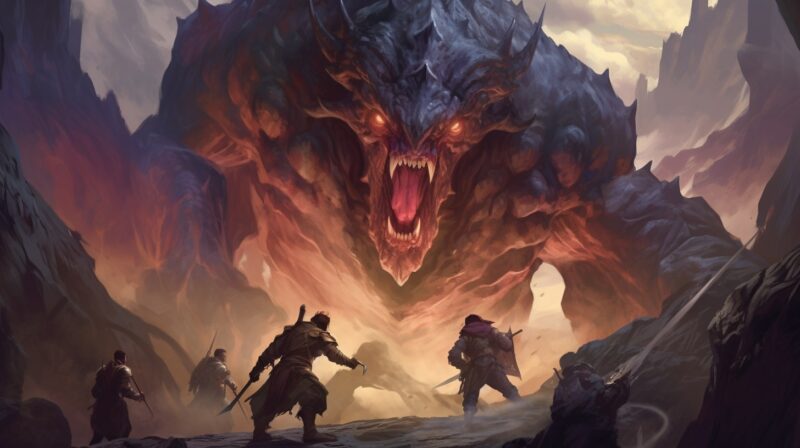Last week all the covers of Dungeons & Dragons 5th Edition were released which made me reminisce over the art and artists that drew me in to the hobby. The cover art and character art are very important with attracting new and old players-the art, the cover is D&D‘s first impression. Art is a large part of roleplaying and tabletop games for me and it transcends editions.
Below are 10 of my favorite artists whose art graced the cover and pages of Dungeons and Dragons since the beginning. While I don’t pick a side in the edition wars, most of the art comes from 4th edition as that was the one that I have played most. This list is to document my favorite artists, which aren’t necessarily the most iconic or the most well known, but they have all played an important role in molding my love for Dungeons and Dragons:
1. William O’Connor:
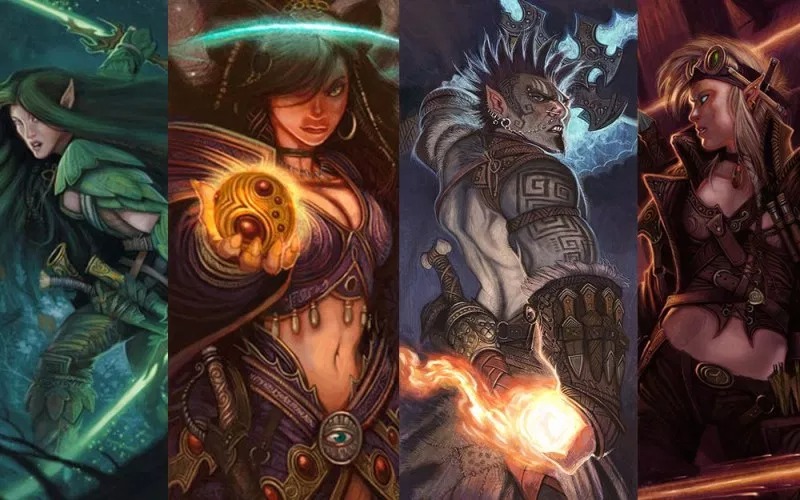
Picking a favorite William O’Connor art piece is as difficult as choosing my favorite barbarian power-they’re all amazing! Together with Wayne Reynolds, those two carried 4E with their bold and action-driven covers, settings and characters. His most notable work in 4th Edition (after being the main concept artist for the line, of course) was in the first Player’s Handbook where he designed all the heading art for each starting class and most of the starting playable races.
These images were so iconic that they were used in multiple Essentials character cards. If you were lucky enough to visit PAX during 4E’s run, many of the character promo cards featured in the WotC booth were those same images.
William O’Connor even gave life to some of the most odd and hard-to-conceptualize characters and classes of 4E like Dragonborn and all the Psionic classes. His color schemes are vivid and he favors the orange/warm vs blue/cold motif a lot in his illustrations especially when there are magic items and powers involved.
He also has a distinct armor style that is very attentive to the different classes and their armor preferences. When I began illustrating my own characters, it was his work that I referenced the most. Though his website doesn’t include all of his work, you can find almost any piece of his in a Google search including his contributions to the Accordlands RPG/CCG/LCG (the setting of my first ever D&D campaign).
2. Brom:
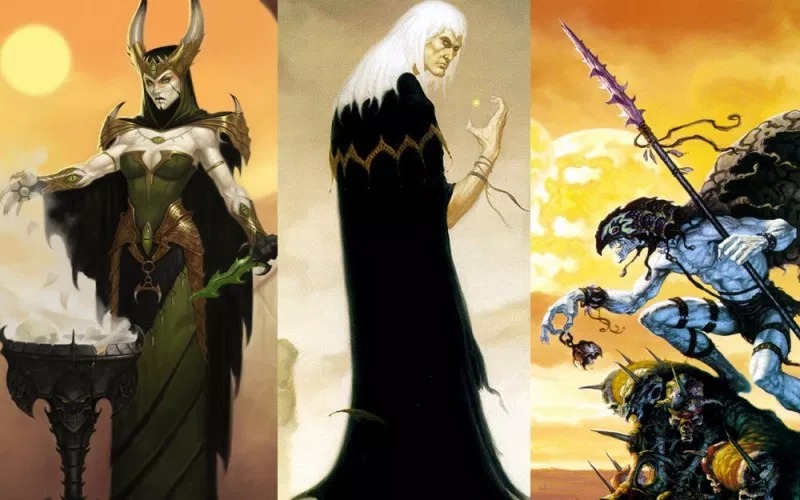
I couldn’t go any further in this article without mentioning Brom. Looking at his portfolio, I couldn’t believe that his art was ever part of this franchise because it is so gothic and so stylistically different from the current D&D editions. Brom’s art in general has a way of unnerving the viewer. His black and white contrast in his characters serve as an unsettling reminder that we have both good and evil in ourselves.
Brom’s most notable contribution was to Dark Sun in 2nd edition, which is a place of deserts, bandits and devoid of high magic. Characters in that setting were wild and survivalist. His art style was perfect for depicting the characters of this setting and they definitely have a Mad Max, surrealist quality that really set that world apart and made it different and interesting to gamers.
Brom is and always will be a legend in the D&D art realm. Meeting him in person was a day I’ll remember forever. To see his illustration, prints and other publications, visit hiswebsite.
(EDIT: Thanks geneome for catching my error. The first image in the Brom header is actually a piece by James Ryman called “Dark Sun Witch”: http://namesjames.deviantart.com/art/Dark-Sun-Witch-44823672)
3. Larry Elmore:
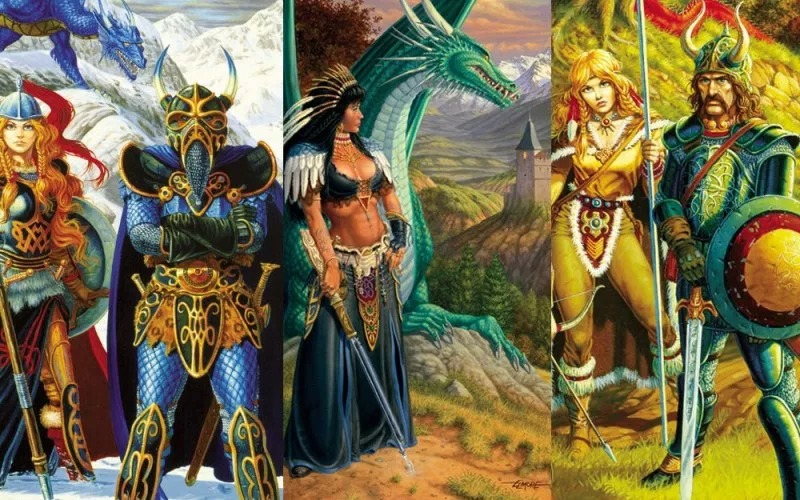
Here is another Godfather artist of D&D! Larry Elmore is responsible for giving Dragonlance its medieval fantasy world filled with dragons and knights. His paintings were always more grand in scale. Instead of a character portrait, he was better known for having posed adventuring characters in front of a dragon or evil that the heroes must combat on a snowy cliff or outside of a castle.
He inspired thousands of other artists to pursue creating fantasy art and made the most iconic cover of D&D: The Red Box of the revised basic set of Dungeons & Dragons. Elmore continues to attend cons and is a wonderful person to chat with in person. To view his past and current work, please visit his website where you can also find prints of your favorite Elmore D&D piece.
4. Wayne Reynolds:
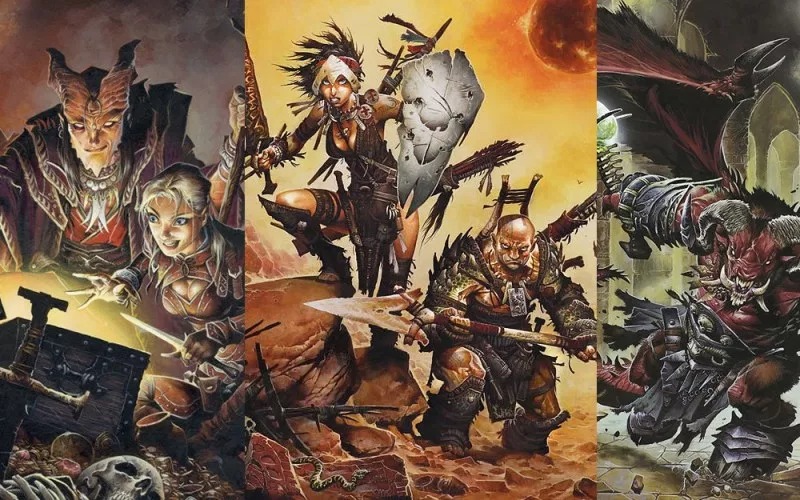
It’s hard to keep up with just how hundreds of unique characters this man has brought to life since first illustrating for Dungeon Magazine in 1999. Reynolds is known for his ultra-detailed, fully-armored adventuring characters that players want their characters to emulate. He illustrated a ton of cover art and inside art for D&D 3.5 and 4E, especially with Eberron.
Reynolds is also well known for being an artist that portrays mostly equal amounts of female vs male and white vs non-white characters in his illustrations. By creating such detailed and unique designs for everyone, characters of color are more than just a sidekick and his female characters are more than just a set of boobs.
He is currently the man behind the art of Pathfinder but in spite of that, I can appreciate his art for both games without getting into the nitty-gritty of what system goes with them. He also has an art book coming out which I am insanely excited for! Find more info about the book and his illustrations on his website.
5. DiTerlizzi:
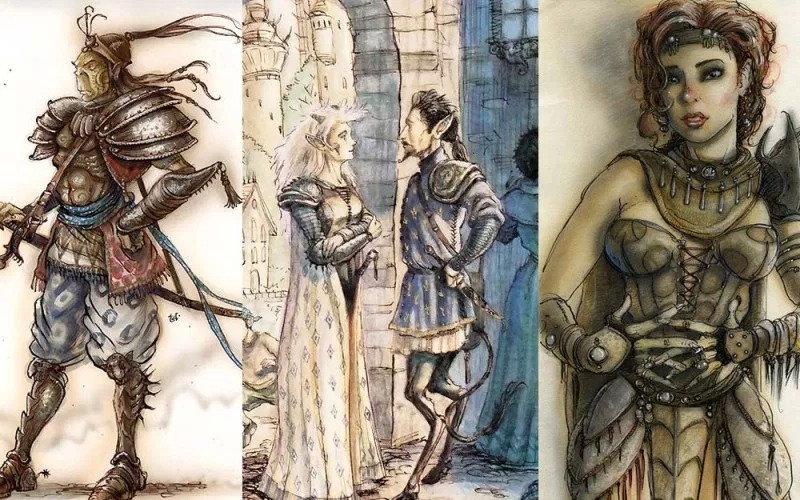
I actually never would have crossed DiTerlizzi’s art if it hadn’t been for my interest in Magic the Gathering cards a couple years ago. I was very interested in another artist’s work, Rebecca Guay, and her watercolor illustrations that felt right out of a children’s book of medieval tales about knights, princesses, magical creatures and nymphs. Luke told me that I would like DiTerlizzi’s work because it was of a similar style.
Looking at his vast portfolio of work from Planescape, I fell in love with his work for its gracefulness. So much art in D&D portrays the fighting and gritty aspects, but DiTerlizzi’s showcased another side of the world where a distant plane and adventuring setting can be fantastical like a world in a fairy tale.
DiTerlizzi continues to create illustrations and inspire artists and fans alike mostly and unsurprisingly in children’s books, but you can still find his older work on his online portfolio and blog.
6. Sarah Stone:
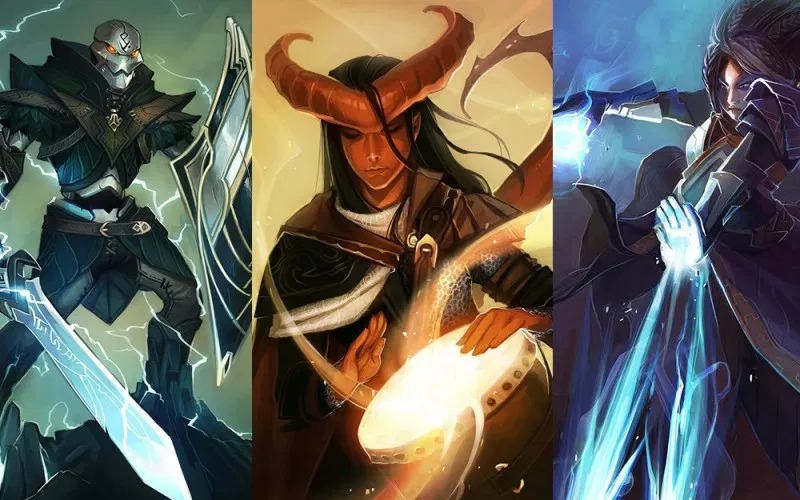
This artist is certainly not a household name compared to others on this list. What is so special about her art is that a lot of people have seen her images (thanks to /tg/ and tumblr) and know her art style, yet her name isn’t synonymous with or recognizably tied to her art.
She has an amazing grasp of light and electricity in her character work that makes her characters feel like they are actually wielding magic. I have tried to illustrate wizards and mages before, and it is a lot more difficult than people think to create a magical character that looks believable.
Sarah’s characters draw from anime influences and style with elements like vibrant color profiles, exaggerated character silhouettes and dynamic line work. Sarah has a deviant art page that has been more recently updated than her blogspot-which, unfortunately, has a ton of broken links in her portfolio that were the D&D and Pathfinder art commissions-making her work even more difficult to find.
7. RK post:
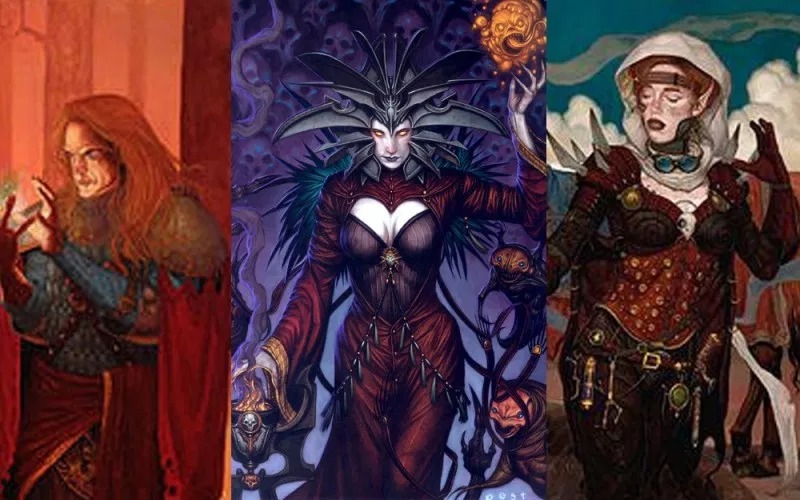
It is difficult to write about Post’s work without being overwhelmed by all his amazing work done on the other massive WotC franchise, Magic The Gathering, but I’ve found his art in both franchises to be very inspiring when creating characters in D&D.
Each of his characters appear to lean towards the evil alignment spectrum or at least provide a neutral first impression. Each character he creates feels like he or she has an epic backstory- they never look like just an evil mage or just a peasant.
rk post’s most recognizable piece in D&D would have to be the lovely lady in the center: The Lady of Pain. Post is by far the funniest and most charming artist I’ve met in person. He really likes art and talking with people at cons. He continues to illustrate and updates Facebook and Twitter regularly with sketches and token cards. He also has recently developed a line of playmats featuring his iconic art from Magic the Gathering which are available on his website.
8. Jeff Easely:
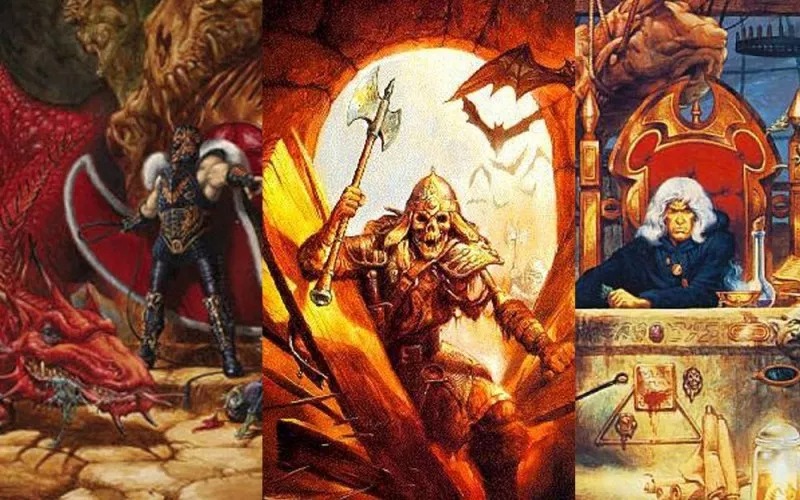
Easley is the artist on this list whom I know the least about. He always had a fascination with D&D monsters and creatures which shows in his paintings. He brought to life many creatures that many gamers would encounter while playing D&D like dragons, undead, skeletons, evil sorcerers and more.
I know many of my friends remember Easley’s work because of its prominence in Advanced Dungeons and Dragons. Like Elmore, Easley had many famous and well recognized paintings associated with D&D but is probably best known for his Dragonlance and Red Dragon images for AD&D. All of Easley’s work past and present is on his website.
9. Eva Widermann:
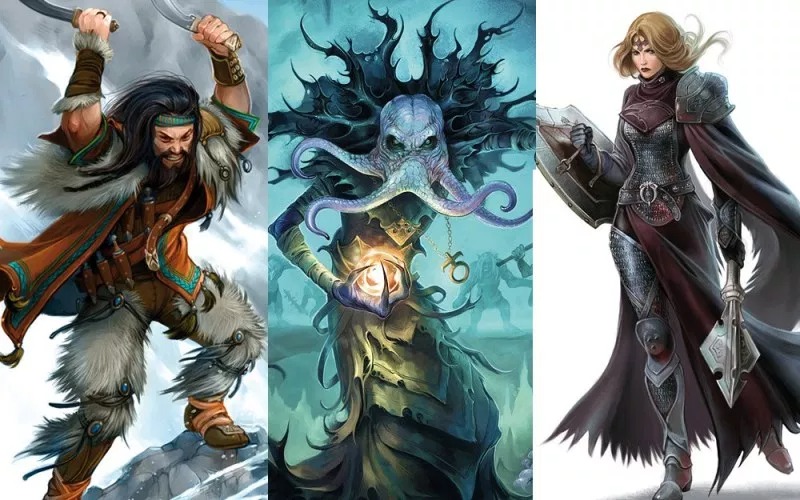
Eva Widermann’s colorful characters feel like they were pulled right out of a history book. She isn’t afraid to keep her fantasy characters rooted in clothing styles and colors of different eras to make her illustrations feel real. While searching though 4E books, players will come across many of her illustrations.
She is best known for her eerie cover illustration for 4E’s Underdark book featuring the iconic Illithid or Mind Flayer. She continues to work as a freelance illustrator and while her website doesn’t have all her characters that were featured in 4E, there are some vibrant illustrations for other WotC properties to see like Kaijudo.
10. Ralph Horsley
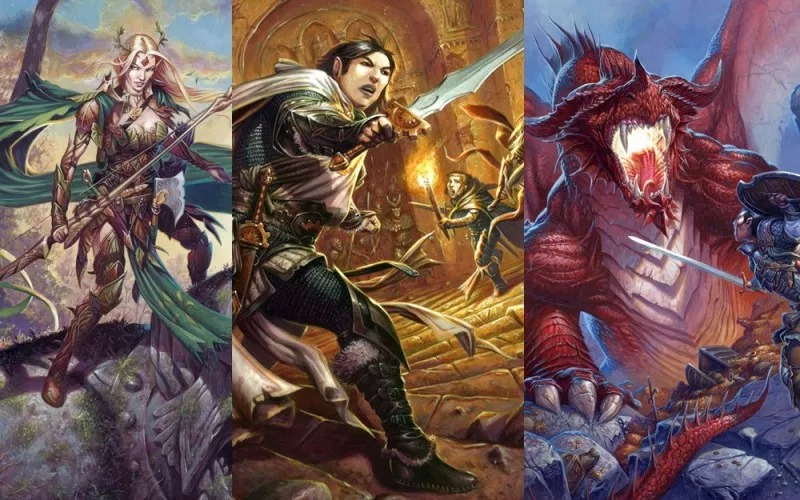
No one can create such a dynamic and tense image like Ralph Horsley. He has tons of covers, chapter headings and more illustrations throughout 4E’s run of adventuring characters encountering a room full of skeletons, battling through trapped dungeons and taking on creepy creatures hiding in a forest.
Horsley’s mid-battle illustrations are detailed and as realistic as they come. A room full of people, plus a dragon, plus environment effects, etc are tons of elements to include in a painting but Horsley’s interpretations shine and add depth and movement to make his illustrations the most memorable.
You’ve probably also seen his artwork on the covers of Fantasy Flight games like Talisman which also feature adventurers fighting dragons and exploring dungeons. His website features his art from a wide range of franchises and companies he’s produced art for.
FAQs
How has D&D art evolved over the years?
D&D art has evolved significantly, reflecting changes in artistic trends, advances in technology, and the evolving tastes of the gaming community. From the classic, hand-drawn illustrations of the early editions to the digital art of today, the evolution of D&D art tells a story of innovation and creativity.
What makes the art of D&D unique?
The art of D&D is unique in its ability to capture the imagination and transport players to otherworldly realms. It combines elements of fantasy, adventure, and mythology, creating a visual language that resonates with players and fans alike.
How does art influence the creation of a D&D character?
Art plays a significant role in character creation, helping players visualize their characters’ appearance, attire, and equipment. It can also inspire the backstory and personality of a character.
How does D&D art inspire players?
D&D art can inspire players in many ways, from sparking ideas for their own character designs to enhancing their appreciation for the rich lore and world-building of the game.
What is the impact of digital art on D&D?
Digital art has opened up new possibilities for D&D, allowing for more detailed and dynamic illustrations. It has also made the art more accessible, with digital tools enabling a wider range of artists to contribute to the game.
How does D&D art contribute to the storytelling aspect of the game?
Art is a powerful storytelling tool in D&D. It helps set the scene, depict key events, and bring the narrative to life in a visually compelling way.
Can I use D&D art for my own campaigns?
While you can certainly draw inspiration from D&D art for your own campaigns, it’s important to respect the copyrights of the artists. Always seek permission before using someone else’s art.
Final Words
While I may not be sold on collecting the 5E books, I am looking forward to the new art coming out that will inspire a new generation of gamers as the previous editions did for me. Clearly I could talke about art for HOURS and would love to discuss who your favorite D&D artists were.
Artistry is the magic that brings our characters to life, the spark that ignites our storytelling, and the vision that guides us through the fantastical realms of Dungeons & Dragons.
I clearly left out some of the greats on my list because they weren’t my favorite but Kieth Parkinson, Todd Lockwood, Daarken, Eorl Otus are other iconic artists worth checking out. Who is your favorite?
